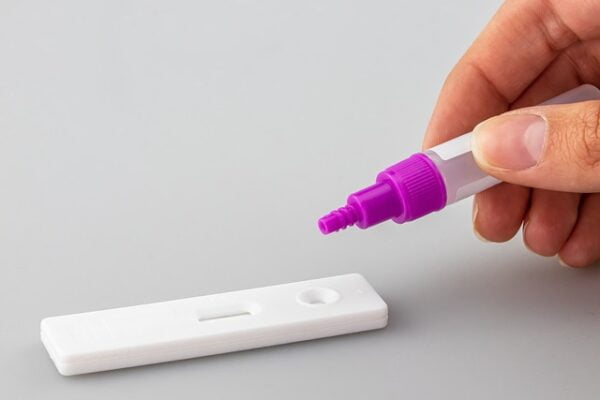As soon as the season starts changing, there is a notable rise in the incidence of throat infections. Soreness, cough, and flu-like symptoms usually accompanied by fever are most commonly reported. The reason behind this sudden spike is associated with the fact that the temperature and overall environment become suitable for the growth of their causative agents. One of these infectious agents belongs to the genus of Streptococcus bacteria which are responsible for pharyngitis or, as it is called, strep throat. Let us understand what sort of tests can be used to detect its presence and how they work.

Common symptoms of pharyngitis include headache, sore throat, and pyrexia
What is Streptococcus bacteria and what infections does it cause?
Streptococcus is a genus that includes circular-shaped bacteria connected together in the form of strings. These bacteria are contagious and are responsible for throat and skin infections. Although pharyngitis (i.e. inflammation of the pharynx due to an infection) can also have viral causes, bacteria are responsible for a significant percentage of the cases.
Overall, 20 to 40% of pediatric patients along with 5 to 15% of adults who suffer from pharyngitis have a group A streptococcal infection. Despite being identical in terms of symptoms, both viral and bacterial pharyngitis do not respond to antibiotic treatment which is only specific to the latter. However, in both cases, the infection only lasts for about a week after which the symptoms start vanishing even if no treatment has been taken.

Microscopic view of bacterial cells
Tests for the detection of Streptococcus bacteria
Keeping in view their high incidence rate, it is advised to test an infected individual with a rapid test strep kit to evaluate if the pathogen is Streptococcus. These rapid tests are of multiple types but have a basic principle of detecting strep antigens. These rapid strep tests (RST), as they are called, include the following:
· Latex agglutination assay:
In the latex fixation test, a number of latex beads are covered with the collected sample with an aim to enrich them with GAS antigen. These beads are further subjected to GAS antibodies which bind with the antigens to cause agglutination which is taken as a confirmation for the presence of Streptococci in the sample.
· Lateral flow test:
Lateral flow test is one of the most widely employed antigen tests for Streptococcus infections. A nitrocellulose film containing GAS antibodies holds the sample. If the Streptococcal antigens are present in the sample, an antigen-antibody reaction occurs resulting in the appearance of a visible line on the strip thus indicating a positive test.
· Enzyme immunoassay:
In the case of enzyme immunoassay, a mixture is prepared by adding the sample containing antigens to the labeled antibody solution. This mixture is then transferred to a film that has previously been incorporated with a substrate. As soon as the reaction occurs, the color of the film starts changing indicating a positive or negative result.

Rapid test kits for different infections
For making a purchase of rapid test kits, visit the website of Health Supply 770 to grab the quality products at the best prices.
How to conduct RSTs to detect Streptococcus bacteria?
Rapid antigen detection tests, abbreviated as RADT, are performed to confirm the presence of Streptococcus in a patient’s throat. For this purpose, a sample is needed which could be tested with antigen solutions. The procedure followed to conduct any of these tests is similar and follows the given steps:
- With the help of a swab, a mucus sample has been collected from a patient’s throat.
- The sample is then subjected to a Strep test reagent which contains an antibody solution.
- As soon as the sample and reagent come into contact, the GAS antibodies start binding with the respective GAS antigen present on the surface of Streptococcal cells, if they are present in the sample.
How do RADT work?
The basic working principle of all the Strep tests is the same. A detection of group A streptococci (GAS) is made in the throat swab with the help of GAS-specific antigens. An antigen-antibody interaction reveals the presence of Streptococcus.
Comparison of accuracy of different RADT
When it comes to the accuracy of a rapid test, two parameters are considered which include:
- Sensitivity: Sensitivity is the measure of how accurate the test is in terms of detecting the disease at any stage. A highly sensitive test indicates a lower chance of getting a false-negative test from it.
- Specificity: In the case of specificity, the ability of the test to differentiate between the individuals who are diseased and those who are not is taken into account. A test with a good specificity percentage has a lesser chance of giving a false-positive result.
An overall specificity of 95 to 100% has been associated with the RSTs which manifests the accuracy of these tests when employed for the identification of a Streptococcus infection. Therefore, a positive result obtained after an RST cannot be neglected as it is highly unlikely for it to be false-positive. A comparison of all the three Strep tests has been given in the table.
| Parameters | Latex fixation test | Lateral flow test | Immunoassay |
| Sensitivity (%) | 98 | 93 | 55 to 94 |
| Specificity (%) | 92.1 | 97 | 81 to 100 |
Conclusion
Among many highly contagious pathogens, Streptococcus occupies a notable place owing to the incidence rate of its infections. Despite not being dangerous or long-lasting, these infections still significantly impair the patient’s day-to-day activities by causing extreme discomfort. Rapid antigen tests are available for the evaluation of the exact cause of these infections.
If Streptococcus bacteria are responsible for the infection, antibiotics can be prescribed to alleviate the symptoms. Although, these rapid tests vary in their costs and the duration in which the results are produced, their accuracies are comparable indicating the reliability of results.

PhD Scholar (Pharmaceutics), MPhil (Pharmaceutics), Pharm D, B. Sc.
Uzma Zafar is a dedicated and highly motivated pharmaceutical professional currently pursuing her PhD in Pharmaceutics at the Punjab University College of Pharmacy, University of the Punjab. With a comprehensive academic and research background, Uzma has consistently excelled in her studies, securing first division throughout her educational journey.
Uzma’s passion for the pharmaceutical field is evident from her active engagement during her Doctor of Pharmacy (Pharm.D) program, where she not only mastered industrial techniques and clinical case studies but also delved into marketing strategies and management skills.
Throughout her career, Uzma has actively contributed to the pharmaceutical sciences, with specific research on suspension formulation and Hepatitis C risk factors and side effects. Additionally, Uzma has lent her expertise to review and fact-check articles for the Health Supply 770 blog, ensuring the accuracy and reliability of the information presented.
As she continues her PhD, expected to complete in 2025, Uzma is eager to contribute further to the field by combining her deep knowledge of pharmaceutics with real-world applications to meet global professional standards and challenges.








